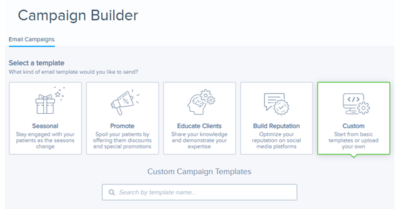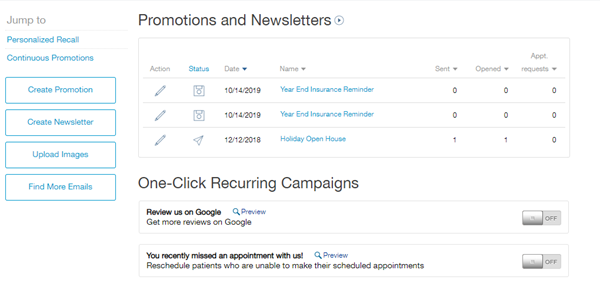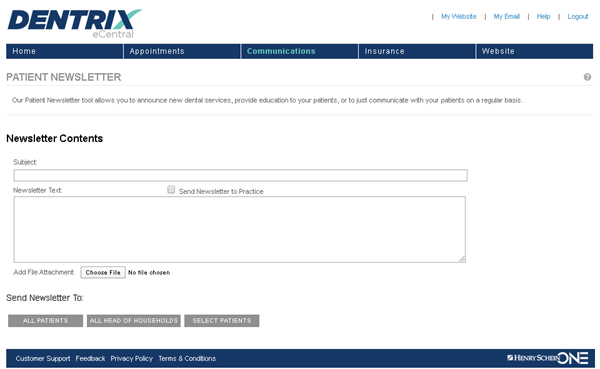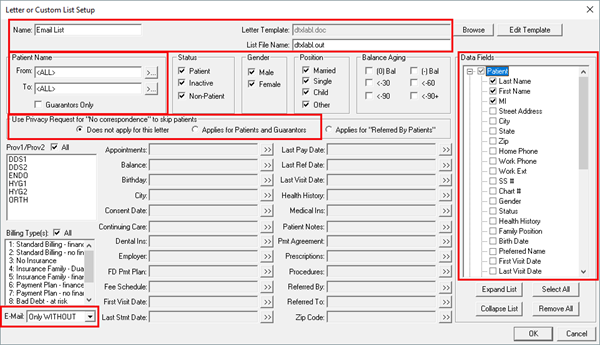Email your patients about your increased safety measures to help them feel confident about scheduling appointments.
Extra sterilization and disinfecting measures are a new part of the normal patient flow these days. In an effort to keep patients and team members safe and healthy, most practices have added new safety measures and office policies to their routines. Your practice is probably no exception.
It’s important to make sure your patients to know about these new precautions and safety measures. In their Patient Return Resource Center, the ADA says “your patients are looking at their own well-being differently—and may have questions when resuming their dental visit.” Communication is key to putting patient’s minds at ease and answering their questions. You can send patients an email to reassure them that you are taking extra steps to ensure their health and safety, and you can also describe what to expect when they come in for a visit.
There are a few different ways you can send an email with Dentrix, depending on which email service you use. Click on the option below that applies to your practice to learn how.
- I have Dentrix and Patient Engage
- I have Dentrix and Dentrix Communication Manager
- I have Dentrix and use Microsoft Outlook for email
- I have Dentrix and use a web-based email service (Gmail, Yahoo, Outlook.com, etc)
Dentrix and Patient Engage
If you have Patient Engage, you can send an email through the Dentrix Hub.
First, access Patient Engage. From the Dentrix Hub, select Marketing, then Campaigns. If you are on the latest version of Patient Engage you will see the Campaign Builder. If you are on an earlier version you will see Promotions and Newsletters.

If you see Campaign Builder, select Custom, then Blank Template. Enter a campaign name and email subject line. Then click the + sign and select Add Module (meaning email text).
Type in the body of the message, then click Save and Continue. Select the Criteria for your recipients, then click Save and Continue. Schedule delivery and send the message.

If you see Promotions and Newsletters, select Create Newsletter and follow the prompts. Select Create Custom Newsletter and click Next, then enter the campaign name and email subject.
Type in the body of the message, then click Save and Next. Select the recipients for the newsletter, then click Next. Schedule delivery and send the message.
Dentrix and Dentrix Communication Manager
If you have Dentrix Communication Manager, you can email a newsletter to all of your patients with an email address in the Family File.

To create send a newsletter through email, from the DXWeb Toolbar, click the Communication Manager button. Select Patient Newsletter from the menu.
Next, enter your email subject. Select Send Newsletter to Practice if you want the office to receive a copy of the newsletter. It will send to the email that is configured in your account settings.
Type the body of the message. Note that this feature is designed to send basic text only; don’t use URLs or special characters here, or you may receive an error message when you try to send it. Do not include an attachment with the email.
Finally, choose who to send the newsletter to. If you want to send to all patients, click Select Patients and choose a range of From: “a” to To: “z.” Once the list loads, click Select All, then Send Newsletter.
Note: Do not use the All Patients button. This option may result in an error since it will try to send the message to all email accounts in the database, even if they contain invalid email addresses.
Dentrix and Microsoft Outlook
If you have Dentrix and use the full version of Microsoft Outlook for your email service (not the outlook.com web service), you can send emails using the Dentrix Letters & Custom Lists feature with Microsoft Word and the Outlook Mail Merge Wizard feature.
Note: To do this , you must have your business email account configured through Microsoft Outlook. When you send messages, it will use your primary Microsoft Outlook account and display the account name and return email address to your patients as it is entered there.

1. Generate a List of Patients
In the Office Manager, click Letters & Custom Lists. Choose a category (for example, Misc.). Click New. Across the top of the Letter or Custom List Setup window, enter a name for this list (for example, “Email List”).
Next to Letter Template, click Browse and select any of the templates (for example, dtxenvl.doc.) What you pick here is not important because you won’t be completing a mail merge through Dentrix. The main area of this window allows you to set up filters that choose who should receive this message.
IMPORTANT: If a patient qualifies for all selected filters, they will be included in the list of patients who receive the email. If they do not qualify for every filter, they will not be included on the list. If you want all of your patients to receive the email, set as few filters as possible.
Look at the following filters:
-
- Guarantors Only checkbox: In the Patient Name section. Sends the email only to patients set as the head-of-household. If you want all patients to receive the email, do not check this box.
- Use Privacy Request for “No correspondence” to skip patients: By default, this filter is active and Dentrix will skip any patient who has the No Correspondence checkbox checked in the Family File. You’ll need to decide if the message you are sending is important enough that you want to override the patient’s preference not to receive correspondence. If so, change the option to “Does not apply for this letter.”
- E-Mail: Change this option to Only With. Only patients with an email address in the Family File will be included in the list.
- Other Filters: Since you want this letter to go to all patients, clear any other filters that have been set.
At the lower-left, you’ll see the E-Mail menu. Change this to “Only WITH.”
In the Data Fields section on the right side of the dialog box, select the information you want Dentrix to send as part of the merge. At a minimum, expand the Patient category and select E-Mail. If you plan to personalize the message by addressing the patient by name, expand the categories and select the patient information that you will want to use in the email message. A good choice of selections would include Last Name, First Name, MI, Salutation, and Preferred Name.
At the bottom of the Letter or Custom List Setup window, click OK. Then, with your custom email list selected, click the Open in Excel button.
Dentrix will check through all patients to find the ones who qualify for the filters you selected and open Microsoft Excel with that patient list. In Excel, click File, Save As, and save the list as a Microsoft Excel formatted file. Remember the location and file name, as you’ll need to know these later.
2. Write the Email Message
Next, open Microsoft Word to a blank document and create the email message. Don’t worry about the subject line yet; that comes at the very end of these steps.
If you want to personalize the email message by including the patient’s name, click Mailings, then Letter Merge Fields. From the Dentrix Letter Merge Fields panel, you can double-click any of these options to insert a merge field code into your message (as long as you selected the corresponding data field in Dentrix). The placeholder will later be filled in with the patient’s information. The “Salutation (conditional)” code is an excellent one to use, as it will find an appropriate greeting depending on if the patient has a salutation, title, or preferred name typed into their Family File.
3. Walk Through the Mail Merge Wizard
When you are finished composing the message, in Microsoft Word click Mailings and choose Start Mail Merge, then Step-by-Step Mail Merge Wizard. The Mail Merge panel will appear and walk you through six steps.
-
- Step 1: Select Document Type: Select the document type “E-mail messages.” Then at the bottom of the Mail Merge panel, click Next.
- Step 2: Select Starting Document: Since you have already prepared the email message, choose “Use the current document.” Click Next.
- Step 3: Select Recipients: Remember that Excel file you saved earlier? Now is the time to use it! Select Use an existing list, then click Browse. Find the Excel file and select it. Word will walk you through some screens to verify the selection. Then at the bottom of the Mail Merge panel, click Next.
- Step 4: Write Your Letter: Now is a good time to give your message one more review. When you are satisfied with the message, at the bottom of the Mail Merge panel, click Next.
- Step 5: Preview Your Letters: In the Mail Merge panel, you can click through the recipients and preview how the email message will look to your patients when the merge fields are replaced with their names. When you are satisfied with how this looks, at the bottom of the Mail Merge panel, click Next.
- Step 6: Complete the Merge: You’re almost there! Under the Merge heading, click Electronic Mail. The Message Options dialog will appear.
-
-
- In the To: line, choose EMailAddress.
- In the Subject line, type the subject.
- Choose your Mail Format. If you have included graphics or font changes, choose HTML. Otherwise, choose Plain Text.
-
Click OK, and Microsoft Word will deliver the information to Microsoft Outlook to send to your patients.
Cautions: Dentrix support is not trained in Microsoft Office products. If you experience problems configuring your email through Microsoft Outlook, you’ll need to seek help from your internet service provider, your IT support, or Microsoft.
Be aware of any laws and regulations regarding sending emails, including anti-spam laws or rules regarding encryption of email messages that contain protected health information.
Dentrix and a Web-based Email Service
If you have Dentrix and use a web-based email service like Gmail, Yahoo Mail, or Outlook.com for your practice email account, you can export a list of patient email addresses to Microsoft Excel and import that file in your mail system.

In the Office Manager, click Letters & Custom Lists. Choose a category (for example, Misc.). Click New. Across the top of the Letter or Custom List Setup window, enter a name for this list (for example, “Email List”).
Next to Letter Template, click Browse and select any of the templates (for example, dtxenvl.doc.) What you pick here is not important because you won’t be completing a mail merge through Dentrix.
The main area of this window allows you to set up filters that choose who should receive this message.
IMPORTANT: If a patient qualifies for all selected filters, they will be included in the list of patients who receive the email. If they do not qualify for every filter, they will not be included on the list. If you want all of your patients to receive the email, set as few filters as possible.
Look at the following filters:
- Guarantors Only checkbox: In the Patient Name section. Sends the email only to patients set as the head-of-household. If you want all patients to receive the email, do not check this box.
- Use Privacy Request for “No correspondence” to skip patients: By default, this filter is active and Dentrix will skip any patient who has the No Correspondence checkbox checked in the Family File. You’ll need to decide if the message you are sending is important enough that you want to override the patient’s preference not to receive correspondence. If so, change the option to “Does not apply for this letter.”
- E-Mail: Change this option to Only With. Only patients with an email address in the Family File will be included in the list.
- Other Filters: Since you want this letter to go to all patients, clear any other filters that have been set.
At the lower-left, you’ll see the E-Mail menu. Change this to “Only WITH.”
In the Data Fields section on the right-hand side of the dialog box, expand the Patient category and select Last Name, First Name, MI, and E-mail.
At the bottom of the Letter or Custom List Setup window, click OK. Then, with your custom email list selected, click the Open in Excel button.
Dentrix will check through all patients to find the ones who qualify for the filters you selected and open Microsoft Excel with that patient list. Once the list is in Excel, select the row of email addresses and click Copy. Start a new email on the web service you use, find the BCC line, and click Paste.
Learn More
To learn more about communicating with your patients using Patient Engage, visit www.dentrix.com/patient-engage.
For more advice about communicating with your patients, read Finding the Right Balance for Patient Communication.





